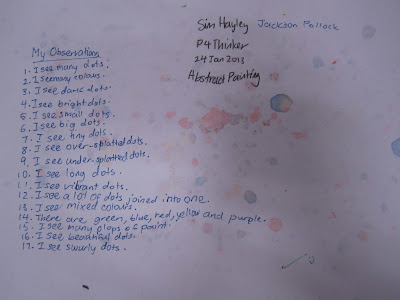
The focus for this term is about colours. Pupils learnt about primary/ secondary colours through artist Jackson Pollock's artwork. They explored the creation of secondary colours despite being given only 3 colours - red, yellow and blue. They wrote down their observations after careful examinations and comparison with Pollock's art. Notice how some pupils wrote what they thought they saw rather than what they really saw. For the subsequent lessons, pupils were encouraged to do research for their 3D sculpture work. They were given jumping clay to work with. Again, the 3 primary colours were given. They will be able to produce secondary colours with them.
Taken from: http://jumpingclayscotland.com/lets-get-started
 |
| Pupils doing their research for 3D sculpture |
We ended the term by giving each other constructive feedback. Pupils were given post-it paper and select artwork which they feel strongly about to comment.





































